Exploring Gender-Specific Health: A Nurse's Reflection on Ailments
VerifiedAdded on 2023/06/03
|7
|1734
|362
Essay
AI Summary
This essay is a reflection by a nursing professional on the differences in health issues observed in male and female wards. The author initially worked in a male general ward and then transitioned to a female ward, noticing distinct patterns in the prevalence of certain disorders. Men were more prone to cardiovascular diseases, diabetes, Parkinson's disease, and lung cancer, while women experienced higher rates of osteoarthritis, osteoporosis, nervous system disorders, and Alzheimer's disease. This experience highlighted the importance of nurses developing expertise in gender-specific ailments to provide effective care and educate patients about their risks. The reflection concludes with an action plan for the nurse to enhance their knowledge and skills in addressing the unique health needs of both male and female patients, advocating for gender-specific health programs, and securing appropriate resources for each ward.
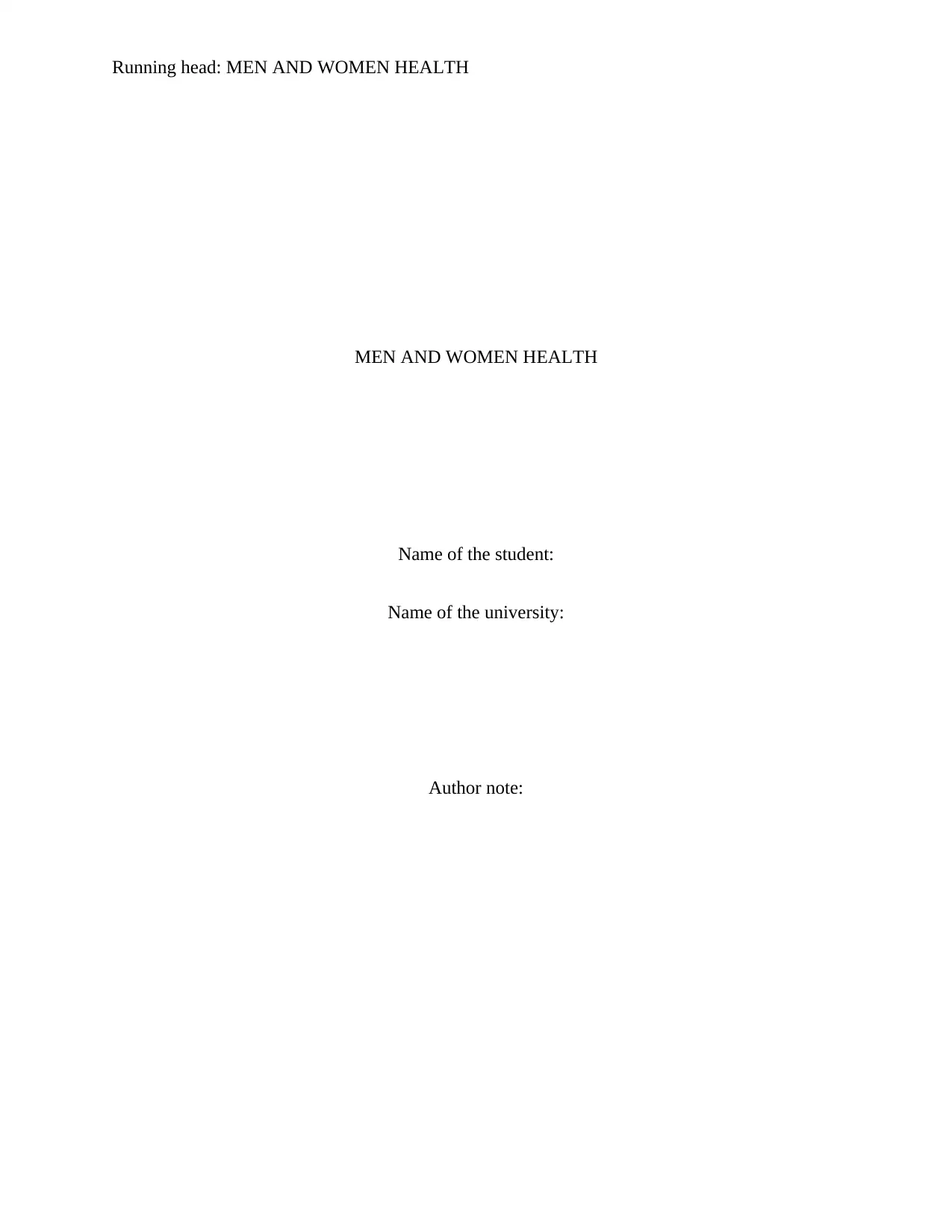
Running head: MEN AND WOMEN HEALTH
MEN AND WOMEN HEALTH
Name of the student:
Name of the university:
Author note:
MEN AND WOMEN HEALTH
Name of the student:
Name of the university:
Author note:
Paraphrase This Document
Need a fresh take? Get an instant paraphrase of this document with our AI Paraphraser
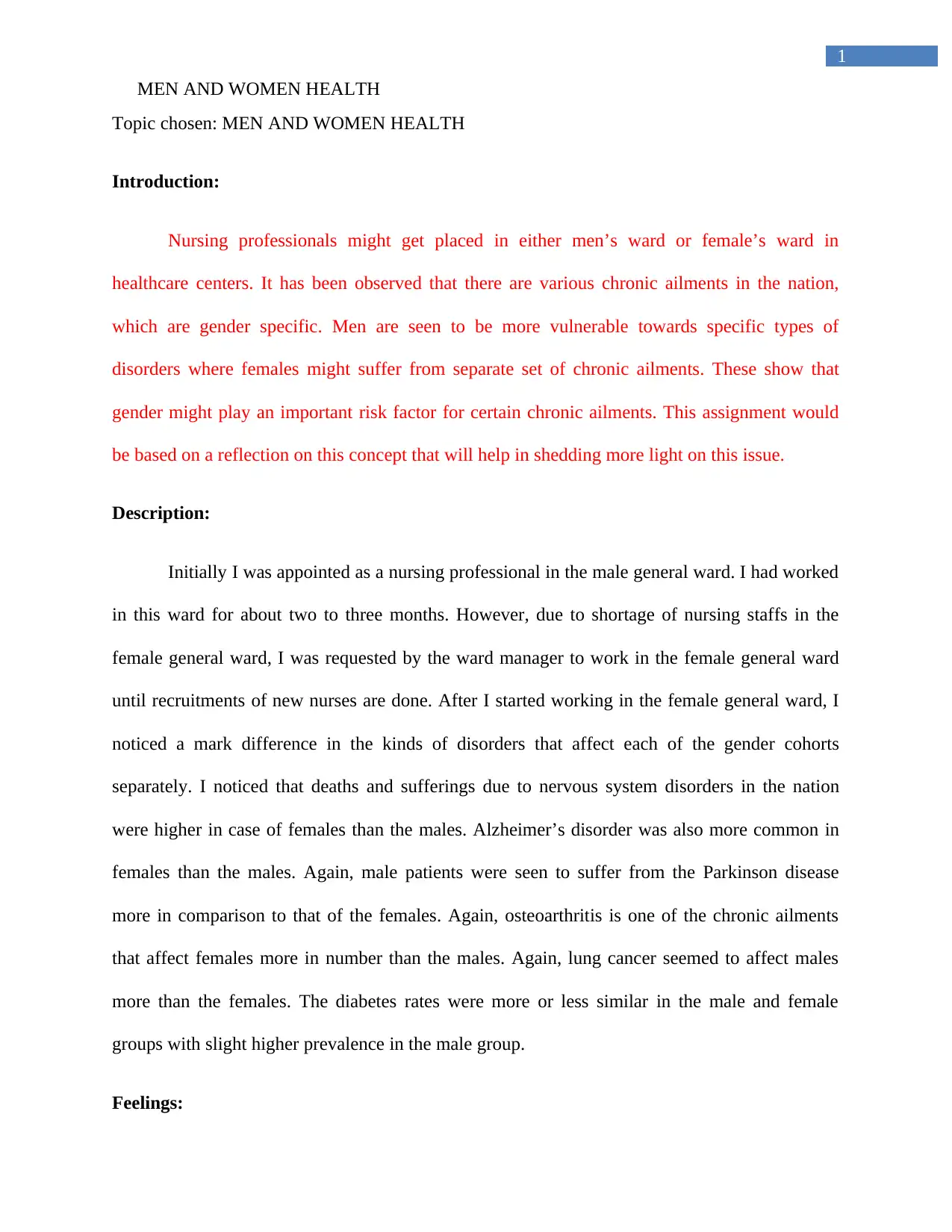
1
MEN AND WOMEN HEALTH
Topic chosen: MEN AND WOMEN HEALTH
Introduction:
Nursing professionals might get placed in either men’s ward or female’s ward in
healthcare centers. It has been observed that there are various chronic ailments in the nation,
which are gender specific. Men are seen to be more vulnerable towards specific types of
disorders where females might suffer from separate set of chronic ailments. These show that
gender might play an important risk factor for certain chronic ailments. This assignment would
be based on a reflection on this concept that will help in shedding more light on this issue.
Description:
Initially I was appointed as a nursing professional in the male general ward. I had worked
in this ward for about two to three months. However, due to shortage of nursing staffs in the
female general ward, I was requested by the ward manager to work in the female general ward
until recruitments of new nurses are done. After I started working in the female general ward, I
noticed a mark difference in the kinds of disorders that affect each of the gender cohorts
separately. I noticed that deaths and sufferings due to nervous system disorders in the nation
were higher in case of females than the males. Alzheimer’s disorder was also more common in
females than the males. Again, male patients were seen to suffer from the Parkinson disease
more in comparison to that of the females. Again, osteoarthritis is one of the chronic ailments
that affect females more in number than the males. Again, lung cancer seemed to affect males
more than the females. The diabetes rates were more or less similar in the male and female
groups with slight higher prevalence in the male group.
Feelings:
MEN AND WOMEN HEALTH
Topic chosen: MEN AND WOMEN HEALTH
Introduction:
Nursing professionals might get placed in either men’s ward or female’s ward in
healthcare centers. It has been observed that there are various chronic ailments in the nation,
which are gender specific. Men are seen to be more vulnerable towards specific types of
disorders where females might suffer from separate set of chronic ailments. These show that
gender might play an important risk factor for certain chronic ailments. This assignment would
be based on a reflection on this concept that will help in shedding more light on this issue.
Description:
Initially I was appointed as a nursing professional in the male general ward. I had worked
in this ward for about two to three months. However, due to shortage of nursing staffs in the
female general ward, I was requested by the ward manager to work in the female general ward
until recruitments of new nurses are done. After I started working in the female general ward, I
noticed a mark difference in the kinds of disorders that affect each of the gender cohorts
separately. I noticed that deaths and sufferings due to nervous system disorders in the nation
were higher in case of females than the males. Alzheimer’s disorder was also more common in
females than the males. Again, male patients were seen to suffer from the Parkinson disease
more in comparison to that of the females. Again, osteoarthritis is one of the chronic ailments
that affect females more in number than the males. Again, lung cancer seemed to affect males
more than the females. The diabetes rates were more or less similar in the male and female
groups with slight higher prevalence in the male group.
Feelings:
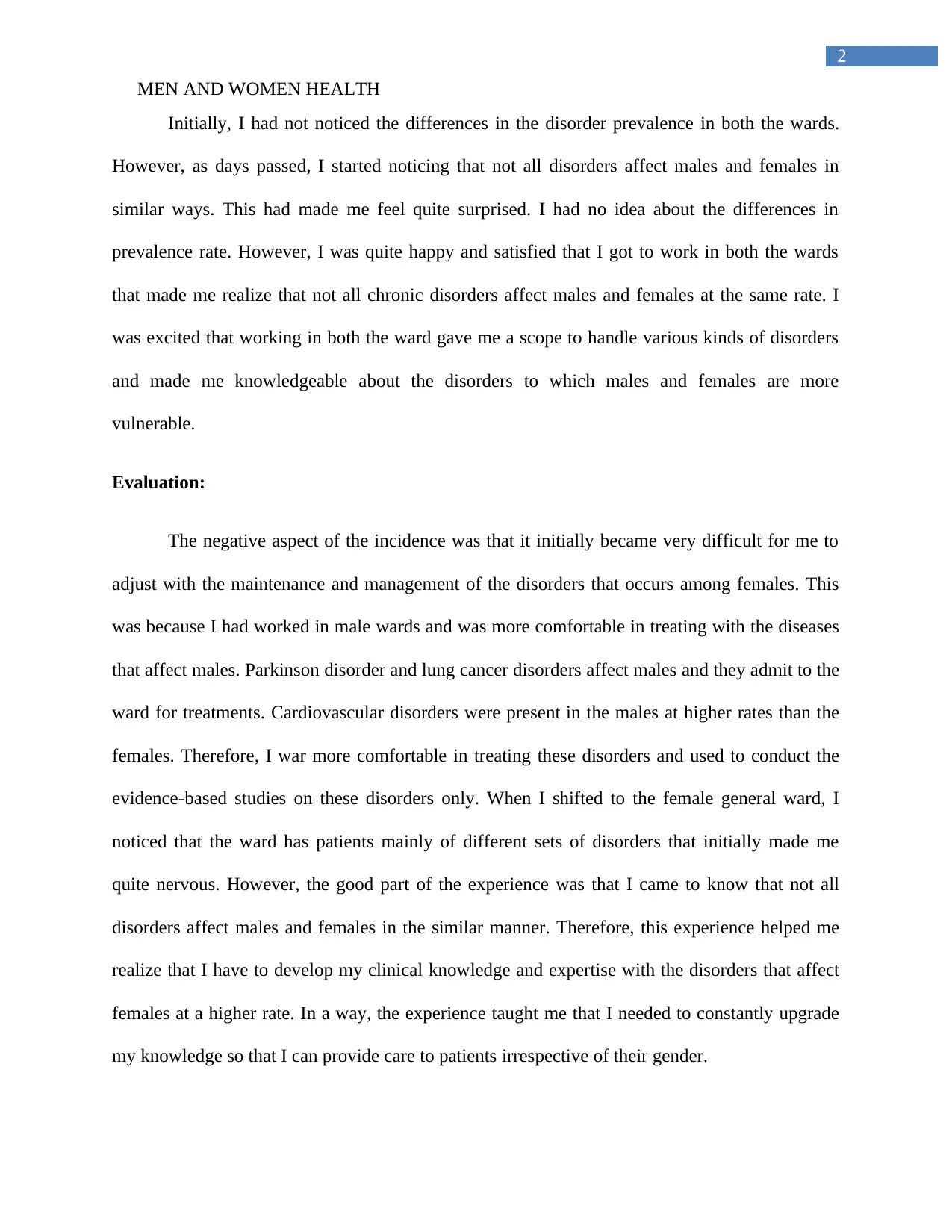
2
MEN AND WOMEN HEALTH
Initially, I had not noticed the differences in the disorder prevalence in both the wards.
However, as days passed, I started noticing that not all disorders affect males and females in
similar ways. This had made me feel quite surprised. I had no idea about the differences in
prevalence rate. However, I was quite happy and satisfied that I got to work in both the wards
that made me realize that not all chronic disorders affect males and females at the same rate. I
was excited that working in both the ward gave me a scope to handle various kinds of disorders
and made me knowledgeable about the disorders to which males and females are more
vulnerable.
Evaluation:
The negative aspect of the incidence was that it initially became very difficult for me to
adjust with the maintenance and management of the disorders that occurs among females. This
was because I had worked in male wards and was more comfortable in treating with the diseases
that affect males. Parkinson disorder and lung cancer disorders affect males and they admit to the
ward for treatments. Cardiovascular disorders were present in the males at higher rates than the
females. Therefore, I war more comfortable in treating these disorders and used to conduct the
evidence-based studies on these disorders only. When I shifted to the female general ward, I
noticed that the ward has patients mainly of different sets of disorders that initially made me
quite nervous. However, the good part of the experience was that I came to know that not all
disorders affect males and females in the similar manner. Therefore, this experience helped me
realize that I have to develop my clinical knowledge and expertise with the disorders that affect
females at a higher rate. In a way, the experience taught me that I needed to constantly upgrade
my knowledge so that I can provide care to patients irrespective of their gender.
MEN AND WOMEN HEALTH
Initially, I had not noticed the differences in the disorder prevalence in both the wards.
However, as days passed, I started noticing that not all disorders affect males and females in
similar ways. This had made me feel quite surprised. I had no idea about the differences in
prevalence rate. However, I was quite happy and satisfied that I got to work in both the wards
that made me realize that not all chronic disorders affect males and females at the same rate. I
was excited that working in both the ward gave me a scope to handle various kinds of disorders
and made me knowledgeable about the disorders to which males and females are more
vulnerable.
Evaluation:
The negative aspect of the incidence was that it initially became very difficult for me to
adjust with the maintenance and management of the disorders that occurs among females. This
was because I had worked in male wards and was more comfortable in treating with the diseases
that affect males. Parkinson disorder and lung cancer disorders affect males and they admit to the
ward for treatments. Cardiovascular disorders were present in the males at higher rates than the
females. Therefore, I war more comfortable in treating these disorders and used to conduct the
evidence-based studies on these disorders only. When I shifted to the female general ward, I
noticed that the ward has patients mainly of different sets of disorders that initially made me
quite nervous. However, the good part of the experience was that I came to know that not all
disorders affect males and females in the similar manner. Therefore, this experience helped me
realize that I have to develop my clinical knowledge and expertise with the disorders that affect
females at a higher rate. In a way, the experience taught me that I needed to constantly upgrade
my knowledge so that I can provide care to patients irrespective of their gender.
⊘ This is a preview!⊘
Do you want full access?
Subscribe today to unlock all pages.

Trusted by 1+ million students worldwide
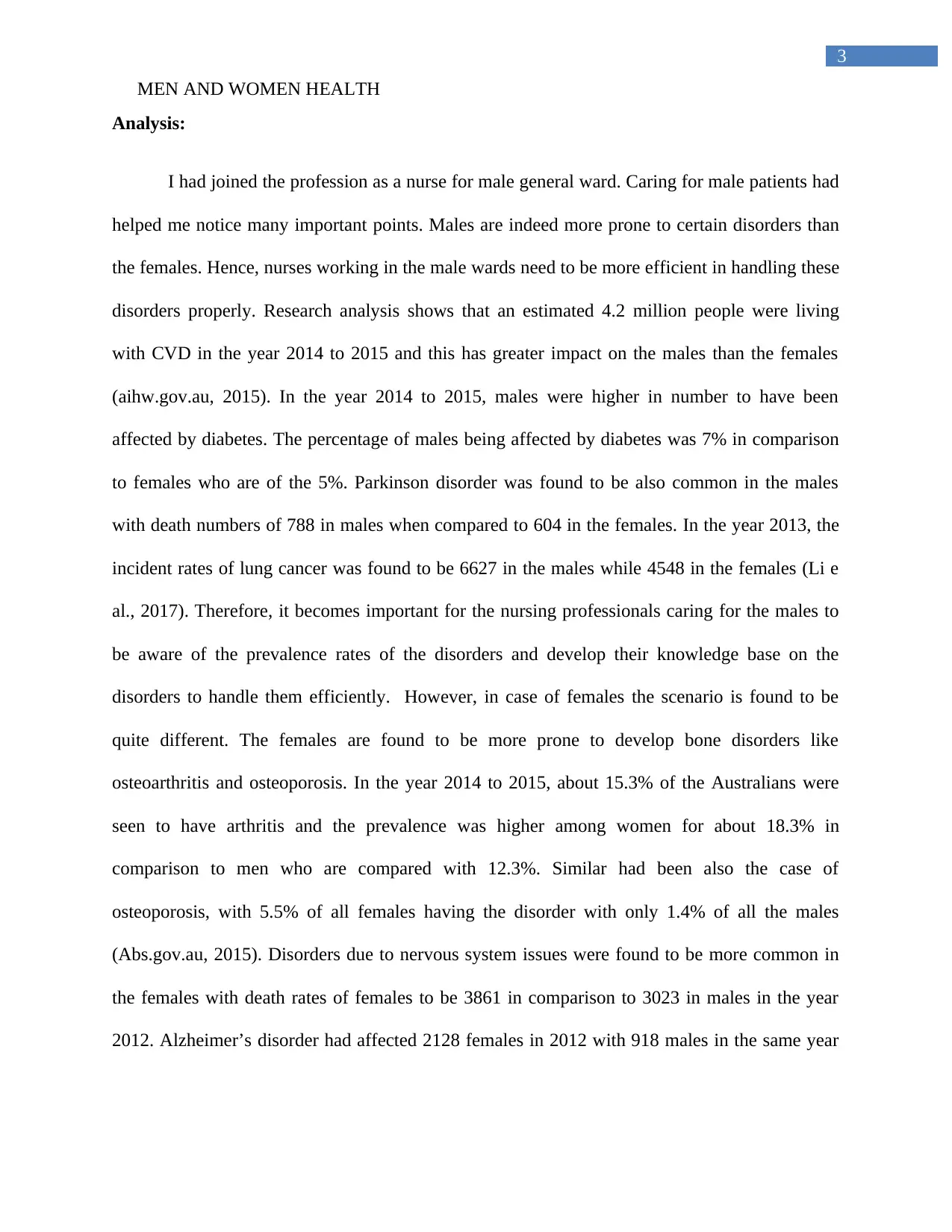
3
MEN AND WOMEN HEALTH
Analysis:
I had joined the profession as a nurse for male general ward. Caring for male patients had
helped me notice many important points. Males are indeed more prone to certain disorders than
the females. Hence, nurses working in the male wards need to be more efficient in handling these
disorders properly. Research analysis shows that an estimated 4.2 million people were living
with CVD in the year 2014 to 2015 and this has greater impact on the males than the females
(aihw.gov.au, 2015). In the year 2014 to 2015, males were higher in number to have been
affected by diabetes. The percentage of males being affected by diabetes was 7% in comparison
to females who are of the 5%. Parkinson disorder was found to be also common in the males
with death numbers of 788 in males when compared to 604 in the females. In the year 2013, the
incident rates of lung cancer was found to be 6627 in the males while 4548 in the females (Li e
al., 2017). Therefore, it becomes important for the nursing professionals caring for the males to
be aware of the prevalence rates of the disorders and develop their knowledge base on the
disorders to handle them efficiently. However, in case of females the scenario is found to be
quite different. The females are found to be more prone to develop bone disorders like
osteoarthritis and osteoporosis. In the year 2014 to 2015, about 15.3% of the Australians were
seen to have arthritis and the prevalence was higher among women for about 18.3% in
comparison to men who are compared with 12.3%. Similar had been also the case of
osteoporosis, with 5.5% of all females having the disorder with only 1.4% of all the males
(Abs.gov.au, 2015). Disorders due to nervous system issues were found to be more common in
the females with death rates of females to be 3861 in comparison to 3023 in males in the year
2012. Alzheimer’s disorder had affected 2128 females in 2012 with 918 males in the same year
MEN AND WOMEN HEALTH
Analysis:
I had joined the profession as a nurse for male general ward. Caring for male patients had
helped me notice many important points. Males are indeed more prone to certain disorders than
the females. Hence, nurses working in the male wards need to be more efficient in handling these
disorders properly. Research analysis shows that an estimated 4.2 million people were living
with CVD in the year 2014 to 2015 and this has greater impact on the males than the females
(aihw.gov.au, 2015). In the year 2014 to 2015, males were higher in number to have been
affected by diabetes. The percentage of males being affected by diabetes was 7% in comparison
to females who are of the 5%. Parkinson disorder was found to be also common in the males
with death numbers of 788 in males when compared to 604 in the females. In the year 2013, the
incident rates of lung cancer was found to be 6627 in the males while 4548 in the females (Li e
al., 2017). Therefore, it becomes important for the nursing professionals caring for the males to
be aware of the prevalence rates of the disorders and develop their knowledge base on the
disorders to handle them efficiently. However, in case of females the scenario is found to be
quite different. The females are found to be more prone to develop bone disorders like
osteoarthritis and osteoporosis. In the year 2014 to 2015, about 15.3% of the Australians were
seen to have arthritis and the prevalence was higher among women for about 18.3% in
comparison to men who are compared with 12.3%. Similar had been also the case of
osteoporosis, with 5.5% of all females having the disorder with only 1.4% of all the males
(Abs.gov.au, 2015). Disorders due to nervous system issues were found to be more common in
the females with death rates of females to be 3861 in comparison to 3023 in males in the year
2012. Alzheimer’s disorder had affected 2128 females in 2012 with 918 males in the same year
Paraphrase This Document
Need a fresh take? Get an instant paraphrase of this document with our AI Paraphraser
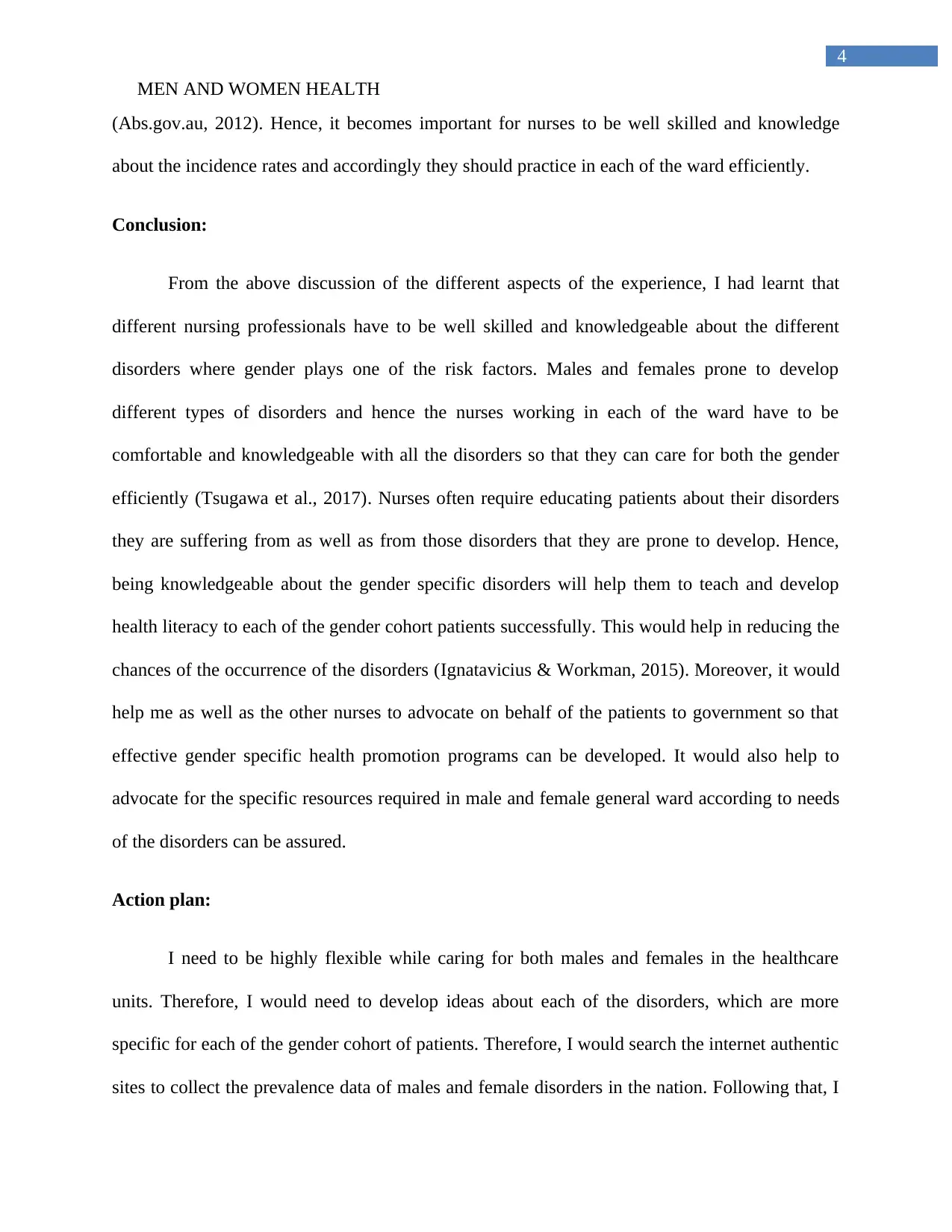
4
MEN AND WOMEN HEALTH
(Abs.gov.au, 2012). Hence, it becomes important for nurses to be well skilled and knowledge
about the incidence rates and accordingly they should practice in each of the ward efficiently.
Conclusion:
From the above discussion of the different aspects of the experience, I had learnt that
different nursing professionals have to be well skilled and knowledgeable about the different
disorders where gender plays one of the risk factors. Males and females prone to develop
different types of disorders and hence the nurses working in each of the ward have to be
comfortable and knowledgeable with all the disorders so that they can care for both the gender
efficiently (Tsugawa et al., 2017). Nurses often require educating patients about their disorders
they are suffering from as well as from those disorders that they are prone to develop. Hence,
being knowledgeable about the gender specific disorders will help them to teach and develop
health literacy to each of the gender cohort patients successfully. This would help in reducing the
chances of the occurrence of the disorders (Ignatavicius & Workman, 2015). Moreover, it would
help me as well as the other nurses to advocate on behalf of the patients to government so that
effective gender specific health promotion programs can be developed. It would also help to
advocate for the specific resources required in male and female general ward according to needs
of the disorders can be assured.
Action plan:
I need to be highly flexible while caring for both males and females in the healthcare
units. Therefore, I would need to develop ideas about each of the disorders, which are more
specific for each of the gender cohort of patients. Therefore, I would search the internet authentic
sites to collect the prevalence data of males and female disorders in the nation. Following that, I
MEN AND WOMEN HEALTH
(Abs.gov.au, 2012). Hence, it becomes important for nurses to be well skilled and knowledge
about the incidence rates and accordingly they should practice in each of the ward efficiently.
Conclusion:
From the above discussion of the different aspects of the experience, I had learnt that
different nursing professionals have to be well skilled and knowledgeable about the different
disorders where gender plays one of the risk factors. Males and females prone to develop
different types of disorders and hence the nurses working in each of the ward have to be
comfortable and knowledgeable with all the disorders so that they can care for both the gender
efficiently (Tsugawa et al., 2017). Nurses often require educating patients about their disorders
they are suffering from as well as from those disorders that they are prone to develop. Hence,
being knowledgeable about the gender specific disorders will help them to teach and develop
health literacy to each of the gender cohort patients successfully. This would help in reducing the
chances of the occurrence of the disorders (Ignatavicius & Workman, 2015). Moreover, it would
help me as well as the other nurses to advocate on behalf of the patients to government so that
effective gender specific health promotion programs can be developed. It would also help to
advocate for the specific resources required in male and female general ward according to needs
of the disorders can be assured.
Action plan:
I need to be highly flexible while caring for both males and females in the healthcare
units. Therefore, I would need to develop ideas about each of the disorders, which are more
specific for each of the gender cohort of patients. Therefore, I would search the internet authentic
sites to collect the prevalence data of males and female disorders in the nation. Following that, I
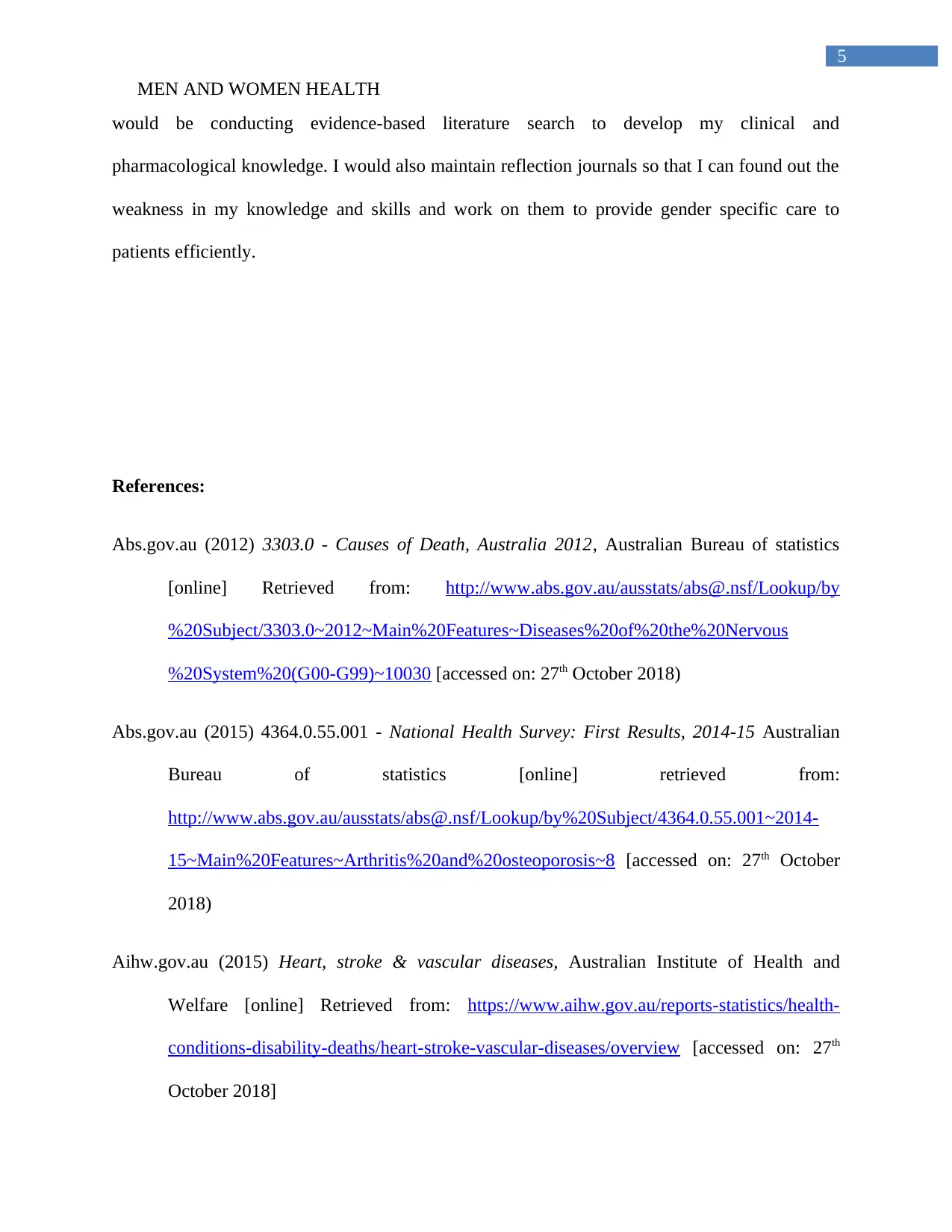
5
MEN AND WOMEN HEALTH
would be conducting evidence-based literature search to develop my clinical and
pharmacological knowledge. I would also maintain reflection journals so that I can found out the
weakness in my knowledge and skills and work on them to provide gender specific care to
patients efficiently.
References:
Abs.gov.au (2012) 3303.0 - Causes of Death, Australia 2012, Australian Bureau of statistics
[online] Retrieved from: http://www.abs.gov.au/ausstats/abs@.nsf/Lookup/by
%20Subject/3303.0~2012~Main%20Features~Diseases%20of%20the%20Nervous
%20System%20(G00-G99)~10030 [accessed on: 27th October 2018)
Abs.gov.au (2015) 4364.0.55.001 - National Health Survey: First Results, 2014-15 Australian
Bureau of statistics [online] retrieved from:
http://www.abs.gov.au/ausstats/abs@.nsf/Lookup/by%20Subject/4364.0.55.001~2014-
15~Main%20Features~Arthritis%20and%20osteoporosis~8 [accessed on: 27th October
2018)
Aihw.gov.au (2015) Heart, stroke & vascular diseases, Australian Institute of Health and
Welfare [online] Retrieved from: https://www.aihw.gov.au/reports-statistics/health-
conditions-disability-deaths/heart-stroke-vascular-diseases/overview [accessed on: 27th
October 2018]
MEN AND WOMEN HEALTH
would be conducting evidence-based literature search to develop my clinical and
pharmacological knowledge. I would also maintain reflection journals so that I can found out the
weakness in my knowledge and skills and work on them to provide gender specific care to
patients efficiently.
References:
Abs.gov.au (2012) 3303.0 - Causes of Death, Australia 2012, Australian Bureau of statistics
[online] Retrieved from: http://www.abs.gov.au/ausstats/abs@.nsf/Lookup/by
%20Subject/3303.0~2012~Main%20Features~Diseases%20of%20the%20Nervous
%20System%20(G00-G99)~10030 [accessed on: 27th October 2018)
Abs.gov.au (2015) 4364.0.55.001 - National Health Survey: First Results, 2014-15 Australian
Bureau of statistics [online] retrieved from:
http://www.abs.gov.au/ausstats/abs@.nsf/Lookup/by%20Subject/4364.0.55.001~2014-
15~Main%20Features~Arthritis%20and%20osteoporosis~8 [accessed on: 27th October
2018)
Aihw.gov.au (2015) Heart, stroke & vascular diseases, Australian Institute of Health and
Welfare [online] Retrieved from: https://www.aihw.gov.au/reports-statistics/health-
conditions-disability-deaths/heart-stroke-vascular-diseases/overview [accessed on: 27th
October 2018]
⊘ This is a preview!⊘
Do you want full access?
Subscribe today to unlock all pages.

Trusted by 1+ million students worldwide
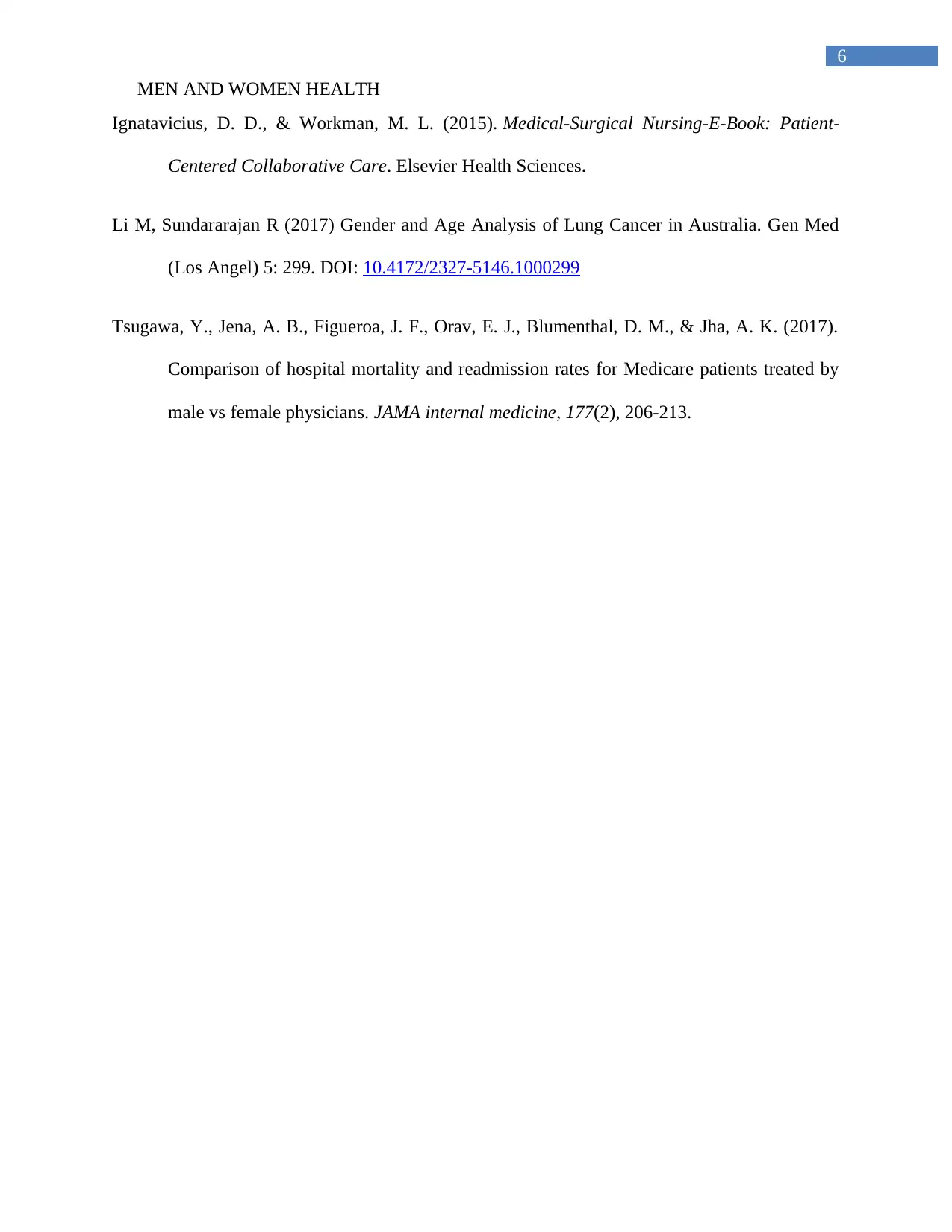
6
MEN AND WOMEN HEALTH
Ignatavicius, D. D., & Workman, M. L. (2015). Medical-Surgical Nursing-E-Book: Patient-
Centered Collaborative Care. Elsevier Health Sciences.
Li M, Sundararajan R (2017) Gender and Age Analysis of Lung Cancer in Australia. Gen Med
(Los Angel) 5: 299. DOI: 10.4172/2327-5146.1000299
Tsugawa, Y., Jena, A. B., Figueroa, J. F., Orav, E. J., Blumenthal, D. M., & Jha, A. K. (2017).
Comparison of hospital mortality and readmission rates for Medicare patients treated by
male vs female physicians. JAMA internal medicine, 177(2), 206-213.
MEN AND WOMEN HEALTH
Ignatavicius, D. D., & Workman, M. L. (2015). Medical-Surgical Nursing-E-Book: Patient-
Centered Collaborative Care. Elsevier Health Sciences.
Li M, Sundararajan R (2017) Gender and Age Analysis of Lung Cancer in Australia. Gen Med
(Los Angel) 5: 299. DOI: 10.4172/2327-5146.1000299
Tsugawa, Y., Jena, A. B., Figueroa, J. F., Orav, E. J., Blumenthal, D. M., & Jha, A. K. (2017).
Comparison of hospital mortality and readmission rates for Medicare patients treated by
male vs female physicians. JAMA internal medicine, 177(2), 206-213.
1 out of 7
Related Documents
Your All-in-One AI-Powered Toolkit for Academic Success.
+13062052269
info@desklib.com
Available 24*7 on WhatsApp / Email
![[object Object]](/_next/static/media/star-bottom.7253800d.svg)
Unlock your academic potential
Copyright © 2020–2025 A2Z Services. All Rights Reserved. Developed and managed by ZUCOL.





